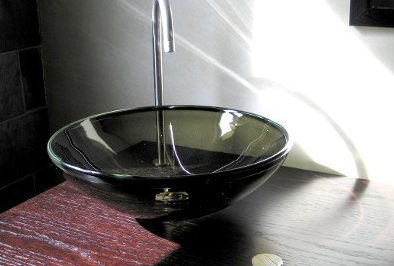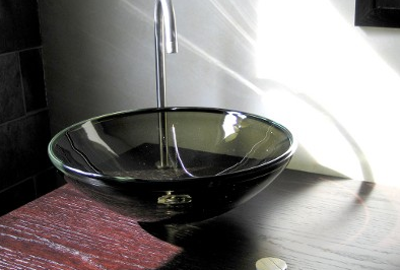
We’re thrilled that you’ve decided to pursue beautiful, artisan sinks for your next project. At this point, you already know the vast benefits of choosing a handmade product crafted with care, versus a mass manufactured, box-store item. What you may be wondering now, are the features for which you should look in artisan sinks, to ensure you’re getting the best bang for your buck. Below are some key characteristics of glass, stone, and copper artisan sinks to keep your eye out for:
Make sure your glass artisan sinks….
… are properly annealed by an experienced artist. Annealing is a critical process of slowly cooling glass to relieve internal stresses. If glass sinks are not properly annealed, they are liable to crack or shatter when subject to temperature change or mechanical shock.
…are made of quality glass. Spruce Pine and Spectrum glass are both manufactured in the US and are made up of the best recipe for quality glass art pieces.
…have consistent thickness. Inconsistent glass thickness on your sink is a sure sign of an inexperienced glass artist.
…are not flat on the bottom. A glass artisan sink should be curved all the way to the drain, so that water flows and does not well up.
… are drilled correctly to allow a level drain. To avoid water welling up around the drain, the drain hole should be beveled to allow the drain to sit level with the glass.
Make sure your stone artisan sinks…
… is made of solid stone. It is unfortunate that many companies pitch their composite stone sinks as “real stone sinks,” when they truly are not.
… has natural voids that are filled. A natural chunk of stone will inevitably have several voids or fissures – those frankly add character and individuality to the piece. Any of those natural features should be filled with a mixture of stone dust and epoxy, however, to match the sink and ensure a smooth, functional product.
… is consistently polished. A genuine artisan stone sink should be polished evenly to accentuate the natural texture, grain, and colors of the sink. Spotty buffing is indicative of an inexperienced craftsman.
Make sure your copper artisan sinks…
… are made of thick, 14-gauge copper. Any thinner than this and your copper sink is at risk of easily denting, and will often sound “tinny” and require sound insulation.
… are made of high-quality copper that does not include lead. Copper sinks should be made out of 99% pure copper and 1% zinc for added strength and integrity. Copper alloys with lead are sometimes used in sinks made in the Middle East, India, and China. Although this alloy is less expensive, lead is harmful to humans and should be avoided.
… are not lacquered. A quality copper sink will have a living finish, that changes and gains patina over time. Some companies attempt to guarantee a consistent finish by adding a coating of lacquer to prevent natural patina. Our experience is that customers with lacquered copper sinks end up unhappy because lacquer will inevitably chip and crack. We make sure to educate our customers about copper’s living finish, so there are no surprises.
… are properly shaped and evenly hammered. Although hand hammered products won’t be perfectly shaped, they definitely should not be “out of square” or “out of round.” The purpose of hammering a copper sink is both to harden the copper and to give the metal its unique handcrafted appearance. Manufactured copper sinks often have fewer and shallower hammer pits, as opposed to our artisan’s tight, beautiful hammered look.
… are properly welded. Many manufactured sinks are quickly welded together with only a few spots of welding material (often containing lead), which can result in failure during shipping or after installation. Genuine copper artisan sinks are TIG welded with copper rod along the entire length of the support.




